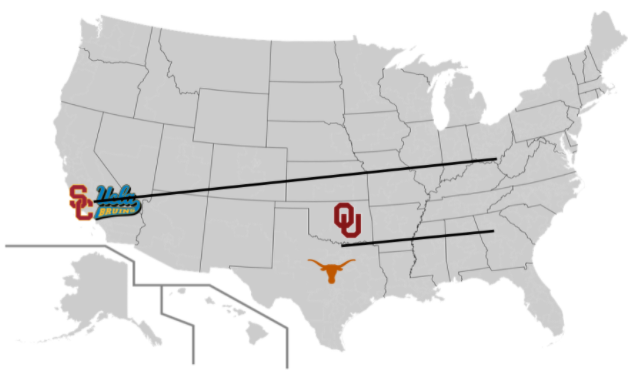College sports’ changing landscape leaves most athletes behind
With the recent conference realignment, USC and UCLA will play games in the midwest while Oklahoma and Texas will travel to the southeast.
A college athlete boards a plane for a five hour flight across the country to play their next game, skipping class to do so. This is not an abnormal occurrence; it’s the future reality for college athletes following the recent conference realignment that changed the entire landscape of collegiate sports.
In the last year, multiple marquee schools decided to switch athletic conferences in order to make more money. The moves are likely just the beginning, as dozens of other universities could follow suit. While this realignment is beneficial for the money-producing sports, football and men’s basketball, it will harm athletes in all other sports.
Oklahoma and Texas kicked off the period of rapid realignment in 2021 when they announced that they would leave the Big 12 for a larger and more profitable conference in the Southeastern Conference (SEC). In June, USC and UCLA followed suit by leaving the PAC-12 after the Big Ten accepted their applications to join. Within the next few years, these schools will officially join their new conferences. And while these schools are the most impactful, many other schools, including Notre Dame, Oregon, Washington, Clemson, Florida State, and Miami, could soon switch their conference alignment as well.
The entire structure of college sports is on the verge of breaking down, and the end result could be two “superconferences,” the SEC and the Big Ten, that control college athletics and hold their own national championship games with the winners of both conferences.
Currently, there are five power conferences in the Football Bowl Subdivision (FBS), the highest level of college football: the SEC, the Big Ten, the ACC, the Big 12 and the Pac-12. The FBS also has a number of smaller conferences and independent teams. The new format would eliminate the ACC, Big 12, and Pac-12 or relegate them to the level of the smaller conferences, leaving the superconferences to expand and control college sports.
The main reason that schools are switching conferences is money. The earning potential in some conferences is greater than others. Two examples are USC and UCLA; the Big Ten just signed a media rights deal with Fox, CBS, and NBC that will pay them seven billion over seven years for the right to broadcast their games. The Pac-12’s deal is only worth three billion, and it is over 12 years. Plus, the Big Ten just signed their deal and it is set to begin on July 1, 2023, while the Pac-12’s deal is running out and they are in the unstable situation of negotiating a new one. The loss of two of their schools will only harm their payout, and it helps widen the growing conference gulf in college sports. But, the Big Ten and the SEC will make billions and draw in more and more teams.
The earning potential carries over to the athletes in football and men’s basketball, who have the opportunity to earn money from Name, Image, and Likeness (NIL) deals. This source of money makes it profitable for those athletes along with the schools, but it would only help athletes in the large conferences. And the main issue is that it only helps athletes in those two sports. Any athlete in any other sport not only does not see any benefit, they do see harm.
They do not have much potential to make money under the current system, as athletes from any sport other than football and men’s basketball typically do not receive NIL deals, though there are exceptions. However, they also would not make money under the new system; and in the new system their lives would become much more difficult.
Instead of traveling within the same region as they do under the current system, college athletes will have to traverse the country. In the SEC, schools like the University of Florida and the University of Oklahoma will play each other. In the Big Ten, USC will travel to play teams like Penn State by crossing a distance of around 2,000 miles. The constant travel is a strain on the tough schedule of a college athlete, as they have to balance sports with education. More travel time means more time out of class and practice and less opportunities to study and train. It also adds more stress. These difficulties are worth it for athletes who can profit off the new system, but for everyone else it is a terrible change. They have to endure the harm with none of the benefits.
And the travel is not the only problem. The changes will harm any athlete at any school who is not part of either the SEC or the Big Ten since most of the money will be funneled there. And all the athletes in non-revenue sports, meaning athletes in all but two, will become less important as college sports increasingly evolves into a business that pursues money from media rights deals and ticket and merchandise sales over the welfare of the athletes.
Overall, the current conference alignment in the NCAA is the result of schools and conferences pursuing money at the expense of the majority of their athletes. In order to prioritize the athletes who actually make the entire system function, the conference realignment should stop.

Ben is a senior in his third year of writing for the Cavalier Chronicle and his second as an editor. His love for writing led him to join the staff, and...












